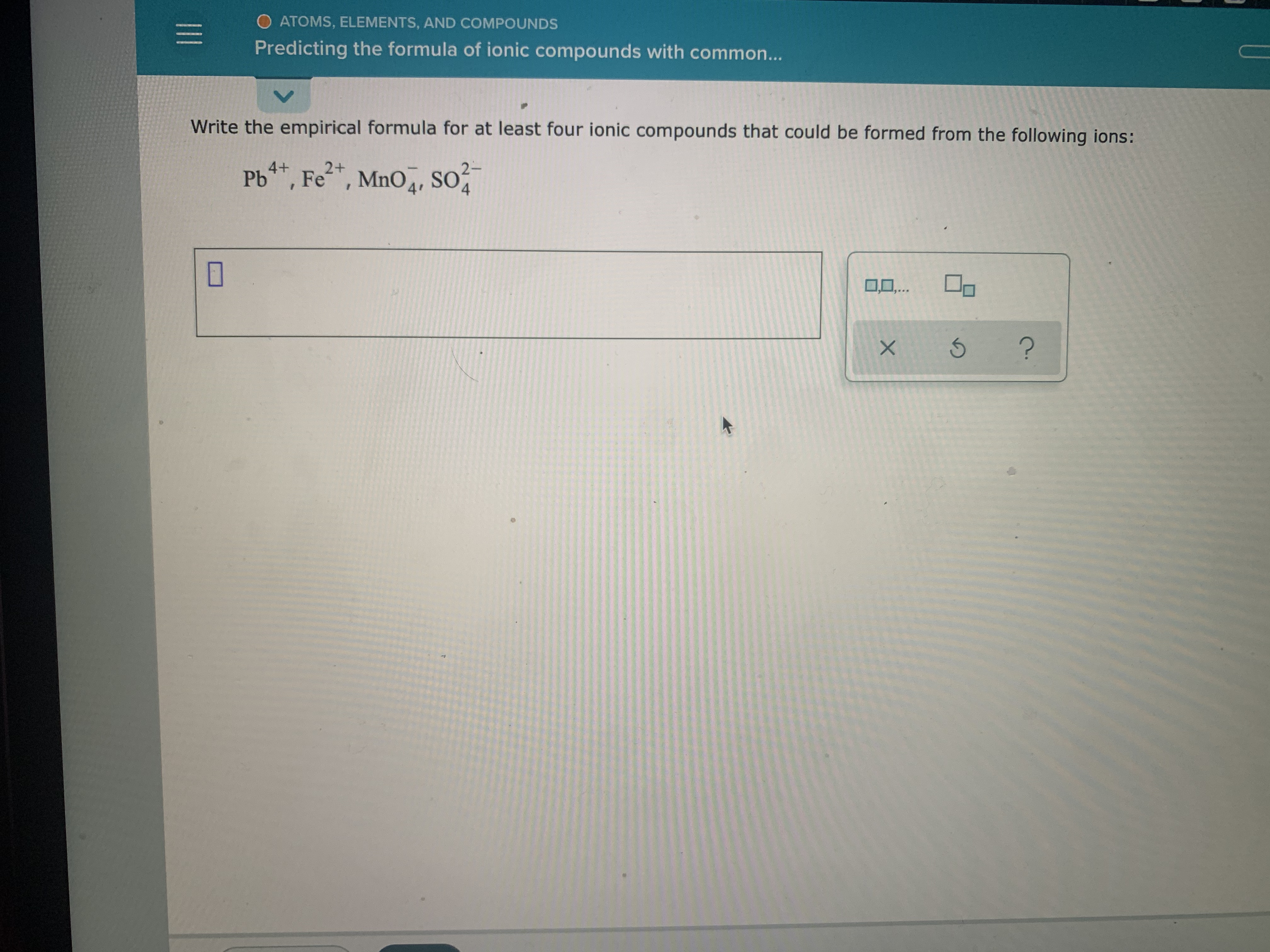
Chemistry
10th Edition
ISBN: 9781305957404
Author: Steven S. Zumdahl, Susan A. Zumdahl, Donald J. DeCoste
Publisher: Cengage Learning
expand_more
expand_more
format_list_bulleted
Question
thumb_up100%

Transcribed Image Text:**Atoms, Elements, and Compounds: Predicting the Formula of Ionic Compounds**
### Exercise
**Write the empirical formula for at least four ionic compounds that could be formed from the following ions:**
- \( \text{Pb}^{4+} \)
- \( \text{Fe}^{2+} \)
- \( \text{MnO}_4^{-} \)
- \( \text{SO}_4^{2-} \)
**Answer:**
1. **Compound 1:** Lead(IV) Permanganate
- Formula: \( \text{Pb(MnO}_4\text{)}_4 \)
2. **Compound 2:** Iron(II) Sulfate
- Formula: \( \text{FeSO}_4 \)
3. **Compound 3:** Lead(IV) Sulfate
- Formula: \( \text{Pb(SO}_4\text{)}_2 \)
4. **Compound 4:** Iron(II) Permanganate
- Formula: \( \text{Fe(MnO}_4\text{)}_2 \)
### Instructions:
To determine the empirical formulas, balance the charges of the cations and anions to ensure the overall charge of the compound is zero. For example:
- For Lead(IV) Permanganate: \( \text{Pb}^{4+} \) and \( \text{MnO}_4^{-} \). Since lead has a charge of +4 and permanganate has a charge of -1, four permanganate ions are needed to balance one lead ion, resulting in \( \text{Pb(MnO}_4\text{)}_4 \).
### Additional Tools
- You can use the provided diagram tool to practice writing the formulas below by clicking on the provided icons.
#### Diagram Tool Explanation:
- The tool includes options to clear your work (X), redo the last action (↻), and request help or additional information (?).
This exercise helps reinforce the principles of charge balance in ionic compounds and develop a better understanding of empirical formula writing.
Expert Solution
This question has been solved!
Explore an expertly crafted, step-by-step solution for a thorough understanding of key concepts.
Step by stepSolved in 2 steps with 2 images

Knowledge Booster
Recommended textbooks for you
 ChemistryChemistryISBN:9781305957404Author:Steven S. Zumdahl, Susan A. Zumdahl, Donald J. DeCostePublisher:Cengage Learning
ChemistryChemistryISBN:9781305957404Author:Steven S. Zumdahl, Susan A. Zumdahl, Donald J. DeCostePublisher:Cengage Learning ChemistryChemistryISBN:9781259911156Author:Raymond Chang Dr., Jason Overby ProfessorPublisher:McGraw-Hill Education
ChemistryChemistryISBN:9781259911156Author:Raymond Chang Dr., Jason Overby ProfessorPublisher:McGraw-Hill Education Principles of Instrumental AnalysisChemistryISBN:9781305577213Author:Douglas A. Skoog, F. James Holler, Stanley R. CrouchPublisher:Cengage Learning
Principles of Instrumental AnalysisChemistryISBN:9781305577213Author:Douglas A. Skoog, F. James Holler, Stanley R. CrouchPublisher:Cengage Learning Organic ChemistryChemistryISBN:9780078021558Author:Janice Gorzynski Smith Dr.Publisher:McGraw-Hill Education
Organic ChemistryChemistryISBN:9780078021558Author:Janice Gorzynski Smith Dr.Publisher:McGraw-Hill Education Chemistry: Principles and ReactionsChemistryISBN:9781305079373Author:William L. Masterton, Cecile N. HurleyPublisher:Cengage Learning
Chemistry: Principles and ReactionsChemistryISBN:9781305079373Author:William L. Masterton, Cecile N. HurleyPublisher:Cengage Learning Elementary Principles of Chemical Processes, Bind...ChemistryISBN:9781118431221Author:Richard M. Felder, Ronald W. Rousseau, Lisa G. BullardPublisher:WILEY
Elementary Principles of Chemical Processes, Bind...ChemistryISBN:9781118431221Author:Richard M. Felder, Ronald W. Rousseau, Lisa G. BullardPublisher:WILEY

Chemistry
Chemistry
ISBN:9781305957404
Author:Steven S. Zumdahl, Susan A. Zumdahl, Donald J. DeCoste
Publisher:Cengage Learning

Chemistry
Chemistry
ISBN:9781259911156
Author:Raymond Chang Dr., Jason Overby Professor
Publisher:McGraw-Hill Education

Principles of Instrumental Analysis
Chemistry
ISBN:9781305577213
Author:Douglas A. Skoog, F. James Holler, Stanley R. Crouch
Publisher:Cengage Learning

Organic Chemistry
Chemistry
ISBN:9780078021558
Author:Janice Gorzynski Smith Dr.
Publisher:McGraw-Hill Education

Chemistry: Principles and Reactions
Chemistry
ISBN:9781305079373
Author:William L. Masterton, Cecile N. Hurley
Publisher:Cengage Learning

Elementary Principles of Chemical Processes, Bind...
Chemistry
ISBN:9781118431221
Author:Richard M. Felder, Ronald W. Rousseau, Lisa G. Bullard
Publisher:WILEY